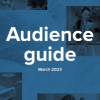How understanding audience segmentation can inform your website user experience
Contents
- Introduction
- 1: Why user journey planning is important
- 2: How using audience segments can improve your user journey
- 3: Practical steps to apply Audience Spectrum segments
- 4: Tips to consider when planning your user journey
- Summary
Topics

In the following guide, our friends at HdK, specialists in digital marketing and web development for arts and culture organisations, discuss the benefits of Audience Spectrum for user journey planning.
Introduction
The Audience Agency’s Audience Spectrum segmentation tool segments the UK into different audience types based on their response to arts and culture. This level of understanding enables you to be strategic and practical in your communication, tailoring key moments of interaction in their user journey, whether that’s through advertising, social media, emails or your website.
Your website is at the heart of all your communications, so it’s important to consider how your audiences engage with it. By using audience segmentation, you can create an enjoyable experience that can improve your connection to your audiences.
In this guide we’ll take a look at:
- Why user journey planning is important
- How using Audience Spectrum segments can improve your website user journey
- Practical steps to apply Audience Spectrum segments
- Some final tips to take away
1: Why user journey planning is important
A user journey maps out the steps your audience will take as they engage with you on their way to complete a goal of some kind, which could be buying tickets, making a donation or signing up to your newsletter.
A great user journey will anticipate a user's interests, needs and pain points which will improve their experience and ultimately strengthen their loyalty and increase your conversion goals.
So, what’s at stake with a bad user journey? People might not find the information they are looking for, they might give up before making a donation or buying a ticket, and it could leave a lasting negative impression.
2: How using audience segments can improve your user journey
There are a number of benefits to understanding your audience by using segmentation:
- It helps you get in the mindset of your audience and enables you to anticipate their needs in order to respond strategically
- It can help make your organisation and brand memorable, by creating personalised enjoyable experiences
- It can strengthen your relationship with existing customers because you’re able to meet their needs
- It improves your communication as you can deliver the right message at the right time
For example, if you are targeting Experience Seekers - who are confident in what they like and always looking for something new - you might explore interactive opportunities. This example is a site we created for Ennio Marchetto. The interactivity is simple but fun, playing with movement and colour. You get a clear first impression of Ennio Marchetto’s character, and it’s an experience from the first point of contact.

Or, if you are targeting Home & Heritage audiences who are interested in history and want to expand their own knowledge, you might want to create moments to encourage curiosity. One example is the Vaughan Williams Foundation website, created by HdK. It includes all the key information about the foundation, but also has pockets of insightful content for their online audience to discover.

3: Practical steps to apply Audience Spectrum segments
Step 1: Understand your audience segments
A good starting point would be to identify which segments you want to target. It’s really important that this is in line with your organisation’s overall goals and audience strategies.
If you’re focused on new audiences, then you might want to have a look at the segments which are well represented in your local population - have a look at the interactive map here
Or perhaps you want to encourage more loyalty and higher spend from your current audience, in which case learning the segmentation of your existing audiences would be a useful exercise – The Audience Agency can help with this.
Once you understand what your main audience segments are, you can create personas based on their interests, needs and possible pain points. Personas are a helpful way to visualise your users, and represent key audiences.
Fill out details of the user persona such as age, location, occupation, influences and habits. Then, consider what is driving them to engage with your organisation - what are their goals? And what barriers or pain points might they be coming across?
At HdK, we use this template we’ve adapted from Figma:

Step 2: Journey mapping
Now you can get in the mindset of your audience, you can start considering how they might engage with your website and how to address their needs.
Start by identifying the main entry points for each audience segment and the steps they should then take to conversion.

By carrying out user journey mapping, you can:
- Explore how users are entering your site and what steps they need to take in order to achieve their goals.
- Identify areas of personalisation such as an upsell to a relevant event, or becoming a member.
-
Identify areas of possible frustration too, and how to minimise these. For example, the order of information, the clarity of key details.
Step 3: Making changes and monitoring impact
You can then start implementing any changes across your website. One way to understand the impact over time, and make further adjustments if needed, is to use Google Analytics to monitor how users are engaging with your website.
Using Google Analytics you can track things like:
- Traffic Source (how users get to your website)
- Behaviour (what content they are and are not interacting with)
- Goal Conversions (how many times certain goals are completed like newsletter signups, donations or clicking on certain media)
Reviewing analytics alongside your audience segments will create a comprehensive view of your audience and how they want to engage with your website, so you can make data-driven decisions and continually improve your website user experience.
4: Tips to consider when planning your user journey
- While this blog has focused on websites, remember to consider what happens before and after users visit your website. This all forms part of the overall journey. How did they get there, and what are they going to do after?
- Audience Spectrum provides insight into people's habits and preferred communication style. This can help you deliver the right messaging at the right time.
- Consider other digital marketing touchpoints as you work through the user journey, such as emails, social media, and adverts. How can these be personalised?
- Remember to use this information alongside other data like Google Analytics, as well as ticketing and sales patterns.
- Finally, you don't have to update and change everything all at once. Instead, focus on improving small areas, which will lead to success over time.
Summary
By understanding your audience segmentation, you have the ability to review and improve key moments in your website experience, helping to meet the needs of your audience and your strategic goals.
Related Guides
- Boost Your Email Marketing with Audience Spectrum - a step by step guide
- How to use Audience Spectrum to Enhance your Funding Applications
- How to Use Audience Spectrum to Inform Your Programme and Engage with Diverse Audiences
- How to use Audience Spectrum to Target Paid Online Advertising
- How to use the Audience Spectrum Segments in your Catchment Area chart on your Overview Dashboard
- Segmentation made simple
- Using Audience Spectrum Subsegments | Speak your benefactors' language
- Using Audience Spectrum Subsegments | Upsell your add-ons more effectively
- Top Tips | Using the Audience Spectrum Subsegments
- Using Audience Spectrum Subsegments | Get personal with your profiling
- Using Audience Spectrum Subsegments | Access your underserved audiences
- Explanation: Mosaic
- What is the Audience Spectrum Enhancement in Spektrix, and how does it work?
- How to get started with applying Audience Spectrum attributes to your Spektrix reports
- Using Audience Spectrum strategically as a customer attribute in Spektrix
- Creating and improving dynamic content in Spektrix using Audience Spectrum
Related Questions
- How do I get set up with the Audience Spectrum Enhancement for Spektrix?
- I have an Audience Spectrum license: why are some of my customer records profiled as ‘Unclassified’ & ‘Unmatched.’
Case Studies
-
 Audience Spectrum in Action | Securing Funding for a Circus Festival
Audience Spectrum in Action | Securing Funding for a Circus Festival
-
 Audience Spectrum in Action | Aberdeen Performing Arts
Audience Spectrum in Action | Aberdeen Performing Arts
-
 Audience Spectrum in Action | London & Culture Calling Arts
Audience Spectrum in Action | London & Culture Calling Arts
-
 Audience Spectrum in Action | Theatr Brycheiniog
Audience Spectrum in Action | Theatr Brycheiniog
-
 How Audience Spectrum helped support Nottingham Playhouse's Levelling Up Strategy
How Audience Spectrum helped support Nottingham Playhouse's Levelling Up Strategy
-
 Looking ahead at Hall for Cornwall
Looking ahead at Hall for Cornwall
-
 Using Audience Spectrum to drive culture change and a major audience development programme
Using Audience Spectrum to drive culture change and a major audience development programme
-
 Audience Spectrum in Action | Edinburgh International Festival
Audience Spectrum in Action | Edinburgh International Festival
-
 Shakespeare North Playhouse: Audience development using Audience Spectrum as a catalyst and tool
Shakespeare North Playhouse: Audience development using Audience Spectrum as a catalyst and tool
